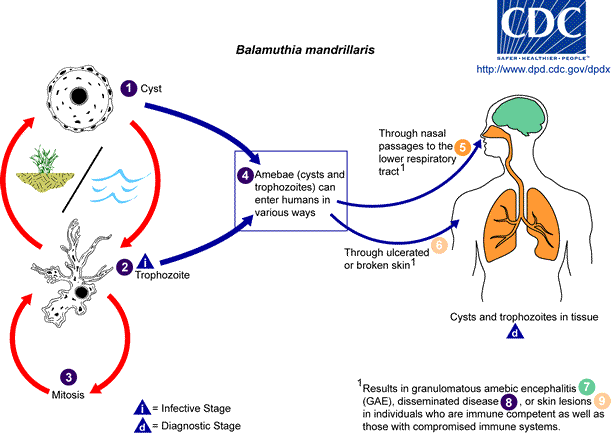Interactions
Naegleria fowleri is a free-living, single celled
organism that is often referred to as the brain eating amoeba
because of the fatal effect it has on humans as well as other
animals such as the
mallard duck and the
domestic dog (Yoder et al. 2010). In its everyday habitat (soil
and moist environments), this organism is known to feed on small
b acteria; but when it inhabits warm bodies of fresh water-lakes,
streams, ponds, rivers- (mostly in southern areas), is when it
becomes the most dangerous and effective to the human
population. N. fowleri is the cause of the deadly
disease known as Primary Amebic Meningoencephalitis or PAM and
is the only known species of Naegleria to infect humans
(Visvesvara, 2010). This disease is very uncommon, in fact
there have only be around 150 cases worldwide since the first
described case in 1965, however it is very deadly with only a
few survivors and a 98% death rate (Fero, 2010). In the
majority of all cases the patient, usually a child or young
adult in good health standing, became infected by N. fowleri
by swimming or bathing in fresh water that was infected with
this organism and getting that water up their noses where the
organism then starts its journey. Once the organism is
inside the nasal cavity it travels to the brain by the olfactory
glands where it then causes great damage to the brain,
specifically the frontal lobe and the central nervous system,
hence why it is called the “brain-eating” amoeba (Visvesvara et
al. 2007). This disease cannot be apprehended through the
mouth; therefore one cannot get PAM by drinking infected water
or as a matter of fact by getting in open sores, the only way is
through the nasal cavity. Also N. fowleri is not
able to grow and survive in chlorinated or treated liquids if
the solutions are treated properly, which makes swimming in a
pool perfectly safe.
acteria; but when it inhabits warm bodies of fresh water-lakes,
streams, ponds, rivers- (mostly in southern areas), is when it
becomes the most dangerous and effective to the human
population. N. fowleri is the cause of the deadly
disease known as Primary Amebic Meningoencephalitis or PAM and
is the only known species of Naegleria to infect humans
(Visvesvara, 2010). This disease is very uncommon, in fact
there have only be around 150 cases worldwide since the first
described case in 1965, however it is very deadly with only a
few survivors and a 98% death rate (Fero, 2010). In the
majority of all cases the patient, usually a child or young
adult in good health standing, became infected by N. fowleri
by swimming or bathing in fresh water that was infected with
this organism and getting that water up their noses where the
organism then starts its journey. Once the organism is
inside the nasal cavity it travels to the brain by the olfactory
glands where it then causes great damage to the brain,
specifically the frontal lobe and the central nervous system,
hence why it is called the “brain-eating” amoeba (Visvesvara et
al. 2007). This disease cannot be apprehended through the
mouth; therefore one cannot get PAM by drinking infected water
or as a matter of fact by getting in open sores, the only way is
through the nasal cavity. Also N. fowleri is not
able to grow and survive in chlorinated or treated liquids if
the solutions are treated properly, which makes swimming in a
pool perfectly safe.
The onset of PAM depends on the size of the organism, the larger it is the faster it will start to affect the internal system, and it will also carry out its process much quicker. But usually the symptoms can be seen anywhere from 24 hours to five days after being infected with this organism (Martinez, 1996). These symptoms include headache, fever, stiff neck, lethargy and in the worst cases seizures and coma these symptoms are similar to those of malaria, although the disease itself is completely different. By the time a patient is diagnosed with PAM it is usually too late to attempt a treatment because of how fast it progresses. In most cases death precedes the onset of the symptoms by seven to ten days. Because this disease is so rare it is hard for researchers to discover the host-specific and environmental factors of this organism, but today scientists are working with other species of Naegleria that closely relate to N. fowleri and testing different factors on mice in a lab setting (Yoder et al. 2010). This gives the scientists better control over the experiments that they run, controls can be tested and variables can be changed in order to further their understanding of this organism and PAM. They do this with hopes in being able to learn how to treat and cure these mice and from there develop new medicines that will increase the survivor rate of this extremely uncommon yet deadly disease.
Previous: Human Cases Home Page Next: Form & Function